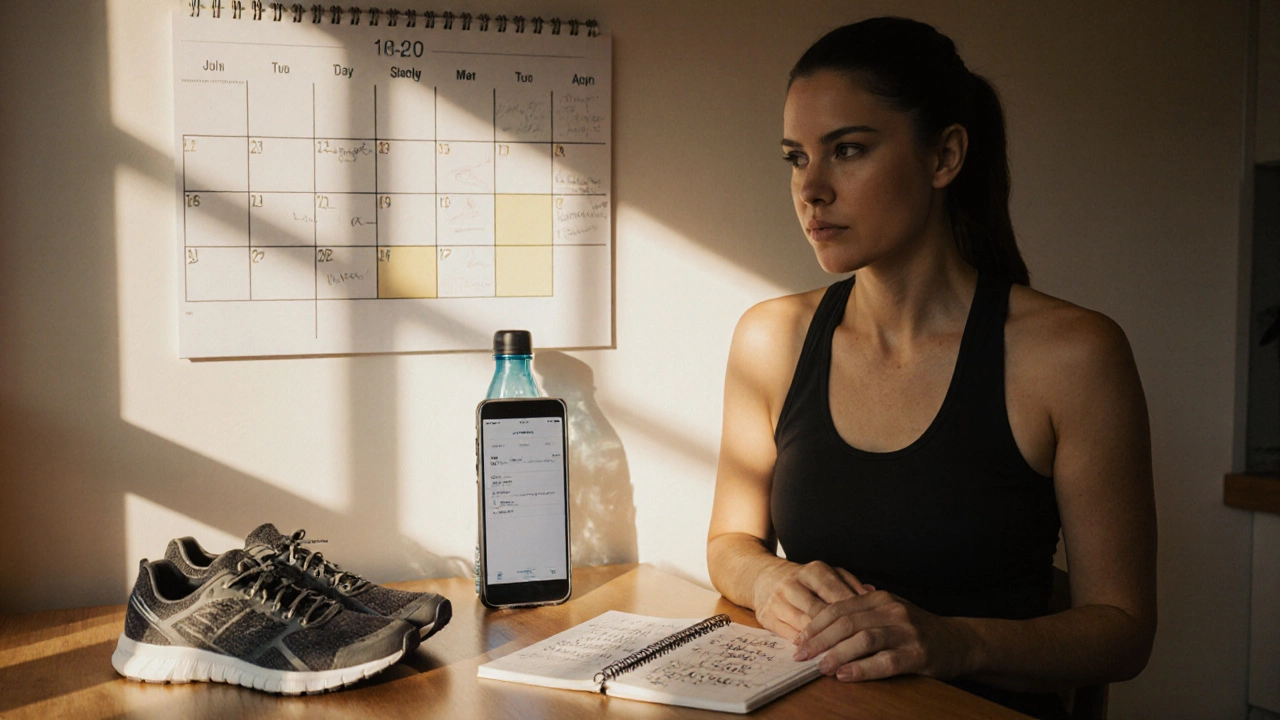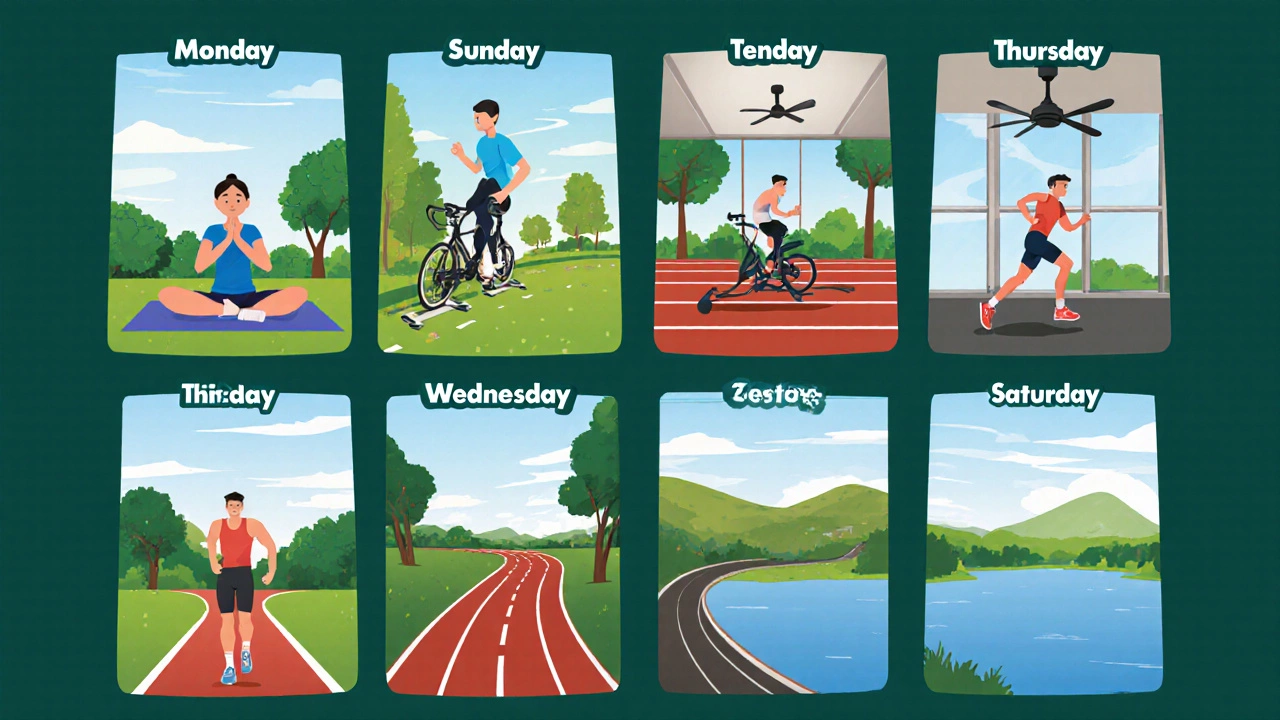
Running October 12, 2025
Marathon Training Timeline for Beginners: How Long Does It Take?
Marathon Training Timeline Calculator
This calculator helps you determine the most appropriate training timeline for your first marathon based on your current running experience.
Your Recommended Training Timeline
Training Duration
Weekly Mileage Progression
Longest Run
Taper Period
Key Recommendations
Starting a marathon can feel like stepping into a whole new world. You probably wonder, "How many weeks do I really need before the big day?" The answer isn’t a one‑size‑fits‑all number, but with a solid plan you can go from couch‑to‑finish line in a realistic timeframe.
Key Takeaways
- Most beginners finish a safe, effective plan in 16-20 weeks.
- Weekly mileage should increase by no more than 10%.
- Long runs, rest days, and cross‑training are non‑negotiable pillars.
- Proper hydration, nutrition, and gear protect you from injury.
- A simple checklist keeps the final weeks stress‑free.
Understanding the Core Elements
Before you dive into a calendar, get clear on the main building blocks of a beginner’s training regime.
Marathon is a 26.2‑mile (42.195km) road race that tests endurance and mental toughness requires both physical stamina and strategic pacing.
Beginner runner someone who has logged less than 20 miles per week and has not completed a marathon before needs a gradual buildup to avoid overtraining.
A well‑structured training plan a weekly schedule that balances mileage, speed work, rest, and cross‑training is the roadmap that guides you from day1 to the finish line.
The long run the weekly longest distance, usually performed at a comfortable pace builds the endurance needed for the marathon’s later miles.
Rest days and active recovery, represented by rest day a full day without structured running to allow muscles to repair, protect you from burnout.
Incorporating cross‑training activities like cycling, swimming, or strength work that complement running improves overall fitness while reducing impact stress.
Consistent hydration fluid intake before, during, and after runs to maintain performance and smart nutrition balanced meals with carbs, protein, and healthy fats to fuel training are the invisible engines behind every successful mile.
Finally, injury prevention strategies such as proper warm‑up, strength work, and gear selection keep you on the road instead of the couch.
How Many Weeks Do Most Beginners Need?
A realistic answer lies in the 16‑ to20‑week window. This range balances three key factors:
- Base fitness: If you can already run 3-4 miles comfortably, 16 weeks is enough. If you’re starting from a more sedentary point, aim for 20 weeks to build a safe base.
- Weekly mileage growth: The 10% rule (increase total weekly miles by no more than 10% each week) caps the speed of progression, naturally extending the timeline.
- Recovery time: Built‑in cut‑back weeks and a final taper give your body time to adapt and consolidate gains.
Below is a quick snapshot of the two most common plans.
| Aspect | 16‑Week Plan | 20‑Week Plan |
|---|---|---|
| Starting weekly mileage | 15mi (24km) | 10mi (16km) |
| Peak weekly mileage | 35mi (56km) | 30mi (48km) |
| Longest run | 20mi (32km) | 18mi (29km) |
| Rest days per week | 2 | 2 |
| Cross‑training sessions | 1-2 (30min each) | 1-2 (30min each) |
| Taper length | 2 weeks | 3 weeks |
Choose the 16‑week version if you already run a few times a week and want a faster path to race day. The 20‑week schedule is kinder to beginners who need extra time to adapt.

Weekly Structure: A Sample 18‑Week Blueprint
Below is a day‑by‑day outline that you can tweak based on personal schedule, weather, and how your body feels.
- Monday - Rest: Full day off or gentle yoga.
- Tuesday - Easy run: 3-5mi at a conversational pace.
- Wednesday - Cross‑training: 30-45min cycling, swimming, or strength work focused on core and hips.
- Thursday - Tempo or interval: 4mi total; warm‑up 1mi, then 2mi at a comfortably hard effort (≈80% max HR), cool‑down 1mi.
- Friday - Rest: Light stretch or a short walk.
- Saturday - Long run: Start at 6mi, add 1mi each week, peaking at 20mi (or 18mi for a 20‑week plan). Keep the pace 60-90seconds per mile slower than race goal.
- Sunday - Recovery run: 2-3mi very easy, or a second cross‑training session if you feel fresh.
Every fourth week, cut back mileage by 20‑30% (a “recovery week”). This signals your body to repair and prevents the dreaded plateau.
Tracking Progress: Simple Metrics to Monitor
- Weekly mileage: Log total miles; stay within the 10% rule.
- Pace trends: Note average pace for easy, tempo, and long runs.
- Heart rate zones: Use a chest strap or wrist monitor to verify effort levels.
- Perceived exertion: Rate each run on a 1‑10 scale; aim for 3-4 on easy days, 6-7 on tempo days.
- Injury signs: Record any niggles-tight calves, shin splints, or sore knees-and adjust accordingly.
Having a spreadsheet or a running app that captures these data points helps you see the big picture and make informed tweaks.
Hydration, Nutrition, and Gear Essentials
Even the best‑planned schedule can fall apart without proper fuel. Here are the basics that keep the miles painless.
- Daily hydration: Aim for 2.5-3L of water, more on hot days.
- Pre‑run snack: 30‑60g of carbs (e.g., banana with a spoonful of peanut butter) 30minutes before you head out.
- During long runs: 30-60g of carbs per hour via gels, sports drinks, or easy‑to‑chew fruit. Practice this in training to avoid stomach surprises on race day.
- Post‑run recovery: 3:1 ratio of carbs to protein within 45minutes (e.g., chocolate milk or a smoothie).
- Shoes: Replace running shoes every 300-500mi. Look for a pair with adequate cushioning and a slightly wider toe box if you experience blisters.
- Clothing: Choose moisture‑wicking fabrics; layer if the forecast calls for cool mornings.

Avoiding Common Injuries
Beginners often stumble over the same pitfalls. Address them early.
- Too much, too fast: Respect the 10% rule and the recovery weeks.
- Skipping strength work: Add two weekly 20‑minute strength sessions focused on glutes, hamstrings, and core.
- Ignoring pain: A dull ache that lasts more than two days signals a problem-scale back or consult a physiotherapist.
- Poor shoe wear: Check wear patterns; uneven soles often mean you need a new pair or a gait analysis.
- Inadequate warm‑up: Spend at least five minutes of easy jogging plus dynamic stretches before every run.
Final 3‑Week Taper Checklist
When you hit week14 (for a 16‑week plan) or week18 (for a 20‑week plan), start dialing back.
- Reduce long‑run distance by 30% each week.
- Keep intensity (tempo/interval) but cut the volume in half.
- Maintain easy runs and cross‑training for blood flow.
- Sleep 7‑9hours per night; prioritize recovery.
- Carb‑load 2‑3 days before the marathon (increase carbs to 70% of total calories).
- Plan race‑day logistics: gear, transport, nutrition stations, and weather contingencies.
Stick to the checklist, and you’ll walk to the start line feeling fresh, confident, and ready to enjoy the experience.
Frequently Asked Questions
Can I start a marathon plan if I’ve never run more than 2 miles?
Yes, but begin with a 20‑week plan that builds a base of 3‑4 miles per run before adding longer distances. The extra weeks give your muscles, joints, and cardiovascular system time to adapt.
How many rest days are too many?
Two rest days per week is ideal for beginners. Adding a third rest day often reduces weekly mileage too much, slowing progress. If you feel overly fatigued, replace a cross‑training session with an extra rest day instead of cutting mileage.
Should I do speed work early in the plan?
Introduce short intervals (e.g., 400m repeats) after the first four weeks, once you have a comfortable base of 15‑20 miles per week. Keep the session short-no more than 20 minutes of hard effort-to avoid injury.
What’s the best way to test my pacing for the marathon?
Run a 10‑mile race or a timed 5‑kilometer run about four weeks before the marathon. Use the average pace from that effort as a baseline, then add 15‑30 seconds per mile for the marathon distance.
Is it necessary to use a GPS watch?
A GPS watch helps you track distance, pace, and heart‑rate zones accurately, which is valuable for staying within the 10% rule. If you don’t have one, use a running app on your phone and review the data after each run.




